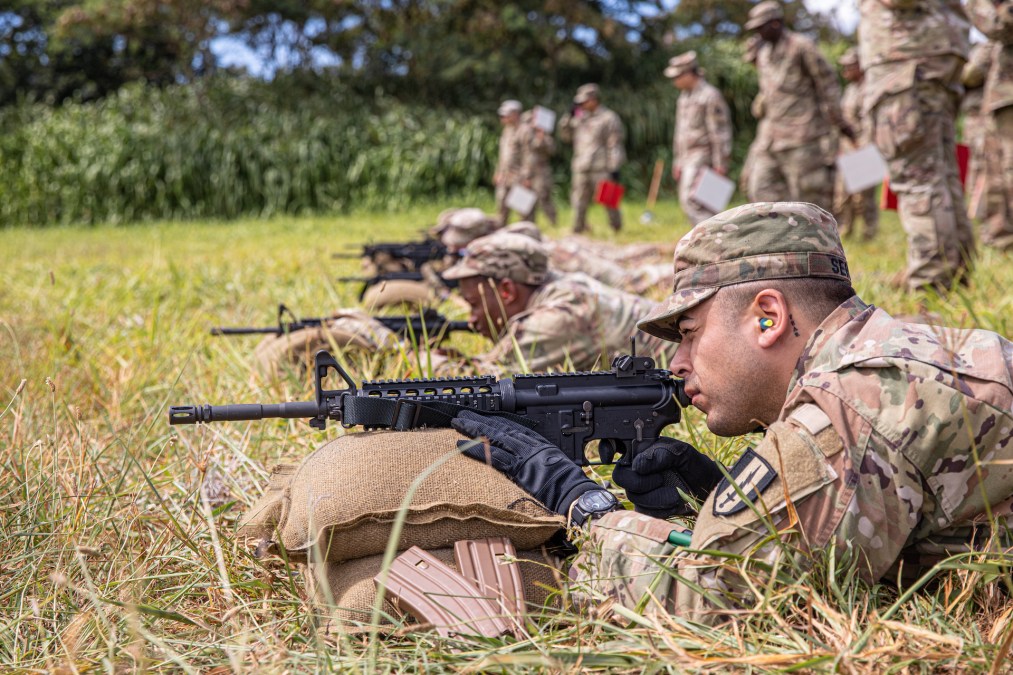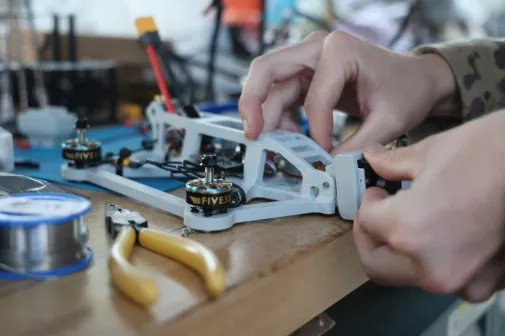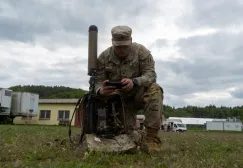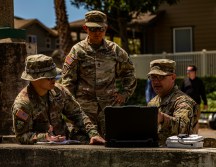Army tests new information unit in Pacific

AUGUSTA, Ga. — The Army recently put its emerging theater-focused information unit to the test in the Pacific, examining how it will interact with other organizations and present data flows for commanders to better understand the information dimension of their environments.
The Army is planning on building three Theater Information Advantage Detachments, or TIADs, focused on synchronizing information capabilities at the theater level. There will be one focused on the Pacific, one in Europe and a transregional unit owned by Army Cyber Command — each consisting of 65 people. Despite some funds set aside to test these organizations, the Army is still awaiting a final force structure decision on resourcing them.
The Pacific unit participated in the Pacific Sentry exercise this summer to assess how it interacts with the theater Army staff as well as adjacent and subordinate units within the theater.
One of the main reasons this formation must exist at the theater Army level, is because that’s where many of the authorities exist. The theater Army is responsible for setting a theater for the entire joint force, Col. John Agnello, director of the Army program office for information advantage at the Cyber Center of Excellence, said during a presentation at the TechNet Augusta conference.
Additionally, coordination between other nations’ militaries and diplomatic officials occurs at the theater level.
Therefore, there is a need to synchronize information-related activities and capabilities at the theater level for commanders.
Agnello noted that there are other organizations that conduct cyber, electronic warfare, civil affairs, public affairs, psychological operations and information operations within the theater, but they were independent and not synchronized.
“What we’re looking at wanting to do with the TIAD is let’s converge that into one organization that can execute it simultaneously in theater, directly answering to the theater Army level commander,” Agnello said.
In the Pacific right now, Gen. Charles Flynn, commander of Army Pacific, redesignated his G39 staff, which is the staff section that deals with information activities, to the TIAD to start working this issue before the Army finalizes force structure and funding.
“Gen. Flynn over there signed the memo that said, ‘I no longer have a G39, I now [have] the Theater Information Advantage Detachment.’ And he started pulling elements throughout his theater Army team to make their TIAD because it’s that important to them … I need this organization to execute information activities in theater, so I’m not waiting … I’m going to go do it,” Agnello said.
An Army Pacific spokesperson told DefenseScoop in June that this decision was made all the way back in November of 2022 as a precursor and to help pave the way for piloting the formation.
“We’ve learned from the stand-up of other new Army organizations over the last few years, working in this way helps ensure a smoother transition/establishment of a new unit of action by establishing processes, funding, manning, and other logistical solutions as well as socialization of concepts with higher level headquarters, the USARPAC staff, and subordinate units,” they said.
“This designation is helping USINDOPACOM and its other service components understand the Army’s direction for information advantage at the Theater Army level. The G39 business has not changed other than support to Army experimentation as part of the Campaign of Learning … The Army conducted an experimental use of a TIAD during Pacific Sentry 23 as part of their Information Advantage Campaign of Learning. USARPAC helped facilitate the preparation and conduct of this particular iteration of experimentation from 8-14 June 2023. The lessons from this iteration will help inform [doctrine, organization, training, materiel, leadership and education, personnel, and facilities-policy] recommendations for Information Advantage,” the spokesperson added.
Once force structure for the TIAD is finalized, the Army Pacific G39 will revert back.
The key distinction between this organization and others — such as the Multidomain Task Forces — is that it’s the only entity specifically focused on information activities in “competition” with adversaries, or below the threshold of armed conflict. The MDTF, Agnello said, is focused on deep, precision fires at the strategic level while the TIAD is focused on tactical support back to the strategic area — ensuring the operational environment is covered with information activities.
Pacific Sentry
Pacific Sentry 2023 provided one of the first opportunities to game out the TIAD — both in terms of how it interacts with other organizations and the capabilities it provides to the theater commander.
“We really wanted to look at how can we use different types of data flows, how can we use different technologies to put the information that’s on the battlefield all the way back, and how can we present it to the commander, the theater level commander, so he can better understand the information dimension,” Agnello said. “How can we present this, all this information in the information dimension, to a commander to make a better, quicker, faster decisions on the battlefield and see his information forces, see all the information that’s out there? How can you present that to them to actually visualize that dimension?”
The TIAD brought a few technologies to the event to build an information overlay, he said, to help commanders visualize the battlespace.
One of the big lessons learned during the event was the need to integrate early. Given the TIAD is meant to engage in competition and help coordinate authorities, having it work with the rest of the theater staff along with other militaries and diplomatic personnel was paramount.
“What we learned in the Pacific theater, we brought them in right before the exercise and actually had them start executing in crisis and conflict. They’re kind of like, ‘Well, you know, there’s not as much things we can be doing, here’s what we would have been doing six months ago, a year ago,’” Agnello said. “Let’s start doing a tabletop exercise or a staff exercise well before the actual execution of the exercise and bring that TIAD in and have them figure out how do you build the [concepts of operation], how do you get the authorities that you need in order to execute these activities, so by the time we bring them in for the actual exercise during crisis and conflict, they’re already six months in.”
As a force in competition, the TIAD can act as a deterrent to ensure operations don’t escalate to crisis or conflict. But, they also had to game out how to hand off information to requisite units if things did escalate to that level.
“How can [we] array forces in competition to not ever really get to crisis and conflict, but at the same time, if we do get to crisis and conflict, how can we use information activities to bring us back to competition?” Agnello said.
The TIAD also worked with the Navy’s Fleet Information Warfare Command Pacific, which acts as the Indo-Pacific Command integrator for information activities.
“We even went in and we actually sat with them for a little while to kind of see how … you guys are doing this and work together to make a common information overlay across the entire theater so all the services can kind of see the same thing. Because the information dimension is huge,” Agnello said.
The information environment is so expansive, he added, that he’s not concerned about “information fratricide.”
“You can’t have information fratricide in the information dimension or environment because there are so much stuff and things to do that as long as you’re following public affairs guidance, you’re meeting your commander’s intent for the theater Army, theater Navy, whatever it may be, and you’re meeting the combatant commander’s intent, you’re never going to be doing too much information activities in the theater,” he said. “You should never have to worry about deconfliction because everyone’s trying to meet a common goal of doing stuff and things.”
Looking ahead to Europe next year
The Army will be setting its sights on the European theater in September 2024 to test the TIAD concept at Avenger Triad, a multinational command post exercise focused on large-scale ground combat operations.
One of the things they’ll be looking at is how would the European TIAD — which will answer to the Army Europe and Africa commander — interact with Army Cyber Command’s transregional TIAD, which will answer to the Army Cyber commander, to achieve common goals.
One of the lessons the Army is taking from Pacific Sentry to Europe is the notion of beginning the planning process early.
“We’re going to start this much earlier so we can actually have the next few activities in competition to figure out how they can do that,” Agnello said. “We actually are going out in September of this year for the … initial planning conference for that and starting to look at how can we inject a Theater Information Advantage Detachment.”






